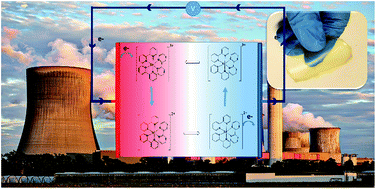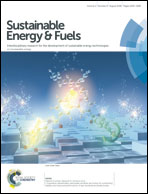Flexible and non-volatile redox active quasi-solid state ionic liquid based electrolytes for thermal energy harvesting†
Abstract
The conversion of low-grade thermal energy to electricity using thermoelectrochemical cells (TECs) is a promising route to sustainable electricity production. Developing a leak-free and flexible electrolyte is an important requirement for increasing the safety of these energy harvesting devices. Here, the addition of polymers to non-volatile redox active ionic liquid electrolytes has been investigated. Polyvinylidene difluoride (PVDF) or poly(vinylidene fluoride-co-hexafluoropropene) (PVDF-HFP) was added to an ionic liquid electrolyte, consisting of a [Co(bpy)3]2+/3+ redox couple in 1-ethyl-3-methylimidazolium bis(trifluoromethylsulfonyl)imide ([C2mim][NTf2]), to produce either soft gels or free-standing films depending on the polymer content. These quasi-solid state electrolytes have a Seebeck coefficient as high as the liquid electrolyte. The effect of gelation, with different amounts of polymer, on the diffusion coefficient of the redox species is reported. Finally, the first thermal energy harvesting performance of a non-volatile, flexible redox active quasi-solid state electrolyte is demonstrated. The quasi-solid state electrolytes allow use of a much thinner electrolyte layer while still maintaining more than half of the power output of the best ionic liquid electrolyte TEC for the same temperature gradient.



 Please wait while we load your content...
Please wait while we load your content...